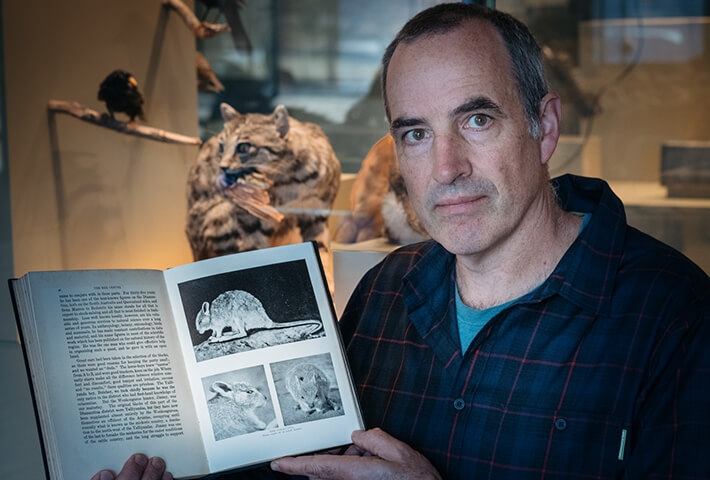It can seem that the world offers little left to discover, but zoologist Karl Vernes wants to find a unicorn — or more accurately, a rat-kangaroo last collected by science in 1935.
Since mammalogist Hedley Herbert Finlayson photographed the desert rat-kangaroo in Sturt’s Stony Desert 83 years ago, the presence of the marsupial has only been hinted at in tantalising anecdotes by stockman and other outback workers.
Associate Professor Vernes, a widely-travelled and published researcher at the University of New England (UNE), has launched a crowdfunding campaign with the aim of supporting himself and three other accomplished scientists on two expeditions into the desert in search of the mysterious animal.
“This is no thylacine, which has been very thoroughly searched for over many decades,” A/Prof Vernes said.
“There have been no substantial efforts to rediscover the desert rat-kangaroo, and there is enough good anecdotal evidence to suggest that it may have been still present at least up until the late 1990s.”
The marsupial “has form” when it comes to lengthy absences from the scientific record, A/Prof Vernes added.
It was first described and drawn in the 1840s, then disappeared from all but anecdote until Finlayson captured and photographed it in the mid-1930s.
After another lengthy disappearance, A/Prof Vernes would like to think that it is time for the desert rat-kangaroo to wander past his camera traps.
If funded, the researchers will set about 50 camera traps in their research zone in the far north-east of South Australia. They will leave the cameras recording for a few months, and then return to analyse the data.
“We’ve planned this research expedition with hope, but no expectation. At the very least, we will do the first ever really thorough search for this animal.”
“And there will definitely be a scientific outcome: we plan to develop the first distribution and habitat model of the desert rat-kangaroo by documenting the vegetation types where it has been recorded and then mapping its likely range using Global Information Systems (GIS) software.”
A/Prof Vernes conceived the expedition after collecting information on the desert rat-kangaroo for about 15 years, which fuelled his desire to see if the elusive animal still exists. He will have expert company.
Dr Stephen Jackson, who works with the Animal Welfare Branch of NSW DPI, has a deep knowledge of mammal taxonomy and is affiliated with the Smithsonian National Museum.
Dr Kris Helgen, formerly of the Smithsonian and now with the University of Adelaide, has described more than 100 new species of mammal, including a racoon-sized mammal he discovered in the cloud forests of Ecuador after being piqued by a skin in a museum.
Todd Elliot is one of A/Prof. Vernes’s doctoral students, an American studying mycophagy (animals who consume fungi, which the desert rat-kangaroo is thought to do) and an alert observer of the natural world.
To mount the expedition, the researchers need a four-wheel-drive for two trips into the South Australian desert. The first, planned for August, would map the marsupial’s likely habitat, and allow for the setting of camera traps and spotlighting.
The second visit, scheduled for some months after the first, would be to retrieve the cameras.
To obtain the US$5400 A/Prof Vernes calculates the vehicle would cost, he has mounted a crowdfunding campaign — his first — on the research funding platform Experiment.com.
Further details, and the ability to support the expedition, can be found on the project page, titled An expedition in search of one of Australia's most mysterious marsupials.


